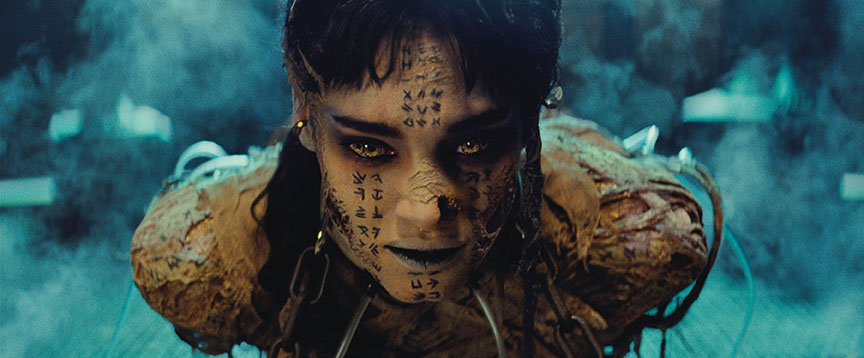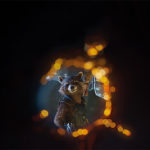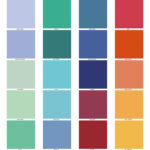
Tomb Raiders
Posted on Oct 20, 2017 by Julian Mitchell
When movie superstar Tom Cruise signed on to The Mummy 2017, major changes happened; one of those was the actioning of a huge zero-gravity sequence
The one thing big movie studios love – and hate their competitors having – is a ‘universe’ of movies. There’s the Marvel Universe and the DC Comic Universe, both hugely successful franchises with a seemingly never-ending supply of comic-based narratives. The Mummy 2017 is Universal’s attempt at starting their own and they brought in the box office star power of Tom Cruise to kick-start it.
The movie was around 97% shot on film apart from three sequences: the underwater scenes,
a chase scene in the tunnels and the zero-G plane crash scenes, on which we are concentrating for this article.
DOP for The Mummy, Ben Seresin, explains the decision to use film. “It was an aesthetic choice,” he says. “It was actually going to cost us a lot more to shoot on film and they were very budget conscious. Alex, the director, and I had spent a lot of time trying to persuade them of our creative decision to go down that route. We were in the midst of it when Tom Cruise was signed. He’s a big fan of film, many of his recent films were shot that way. The decision to shoot film was pretty much made at that point so we were very pleased.”
 Real zero G for the first time in a feature film.
Real zero G for the first time in a feature film.
“It just felt right for this particular project,” Ben continues. “The approach we wanted to take, with it being a monster movie, was to try and create a heightened sense of suspense. We wanted to try and embed that visual aesthetic in reality as much as possible. We were really distancing ourselves from anything to do with the previous ‘Brendan Fraser’ incarnation or really any of the previous versions. This is a contemporary monster movie; I think
part of that process was that we thought film would give it a quality that helped embed it in a reality – it worked for us. That was really the basis of the decision.”
Zero G
The production team had worked out a pretty sophisticated aeroplane crash sequence already and they had decided that there was an opportunity for an elongated destruction of the aircraft but at that point not done for real.
“When Tom came on board he loved all that aspect of it,” says Ben. “He really engineered and drove the process of shooting at zero G. This was something he had wanted to do for a while. There were obviously huge logistical and cost implications but he had powers of persuasion with the studio that we just didn’t have.
 Tom Cruise and Annabelle Wallis not in zero G but in the gimbal set
Tom Cruise and Annabelle Wallis not in zero G but in the gimbal set
“The sequence became a combination of a huge set that we built and the plane itself,” Ben continues. “The set was the interior of the aircraft on a rotating gimbal so we could shoot a lot of the sequence in the studio. It then transfers to the zero-G element when the aircraft starts spiralling out of control. So it was quite a complex range of shooting environments that got us there.
“Building the set alone was a massive job for the SFX team but special effects supervisor Dominic Tuohy did an incredible job with the rig. It was extraordinary: it could roll a full 360˚, and it could bank nose up and nose down a substantial amount. It gave us a great way to interact physically with the main interior. We were then able to build in the zero-G plane elements of that interior. The planning for that sequence started in November 2015 and the zero-G element was the last thing we shot in the movie, which was September 2016; so almost a year of evolving the plan.”
Ducking and diving
The gimbal part of the sequence is the basis of the spiralling of the plane in a high-gravity atmosphere, so the actors are slammed against the walls of the plane. This creates certain story elements that are supported by that sort of action. Then there is a point in the disintegration of the plane when it’s no longer flying but starts spinning in a particular way and it’s that spinning that is married to the zero-G element. So it goes through two distinctly different physical processes. “It meant that we could really elongate the story,” says Ben, “and build in key story points as to what happens to them and their journey within the destruction of the plane.
“There were particular logistics for the zero-G sequence,” he continues. “The plane is an Airbus, operated by a division of Airbus Industries who are based in Toulouse, France. They use the aircraft for flight testing; there are a few different applications, including training astronauts to experience zero G, and also for stress-testing components of aircraft when they’re in zero or high G situations. The plane climbs to around 40,000 feet and then goes into a dive. When it goes into that dive you’re in zero G for around 40 to 50 seconds. The production completed something like 30 of those dives a day for two days! So you’re in this endless cycle of climbing up to a certain point then into the dive, shooting during that weightless time then pulling out of it and climbing once again to do it another time.
 Ben Seresin contemplates zero G in that plane.
Ben Seresin contemplates zero G in that plane.
“As far as the shoot is concerned, there are points in the aircraft that you can use to brace yourself, but there are two issues at play. One is having control of the camera: you can control it as long as you’re anchored somehow, but as soon as you’re floating you have no real ability to deal with holding consistent angles. So the grip basically holds the guy shooting and the grips themselves then have anchor points. Everyone else needs to be anchored so they don’t float into the shot. The other part of that process is the transition from zero G to normal flying. It’s not only that all the equipment – and of course all the people – go from being weightless to having weight, but also, as you pull out of the dive you go into a positive-G environment and the transition has to be very carefully managed. Luckily the process of that transition is well rehearsed and worked out.
“What tends to work better in that kind of environment for shooting is to try and have a sense of what’s going on and maintaining the action,” continues Ben. “What doesn’t work for those sequences is to make it ‘cutty’ and to use too long lenses. You need to sense whatever the environment is, whether it’s high G or zero G. You work on wide lenses and feel the story being told through the interaction of the actors with the environments, that’s what’s interesting. The actors are basically on a physical journey through that space, it’s part of the story. They will do a certain things to brace themselves and organise themselves to get out of the plane and so on. That part of the story includes this physicality, moving around the environment as best they can.”
Moving in G
“We found the best way to show that was to introduce as little movement as possible with the cameras and really be as wide as we could within reason,” Ben explains. “Also editorially keeping the cuts to a minimum.
“One of the sequences on the set was a shot with Tom Cruise and Annabelle Wallis where the plane went through two 360˚ rotations. The actors were just being thrown about; we effectively kept the camera pretty static. In another part of the sequence we strapped the camera to the centre of the plane’s body so the camera rotated with the plane as well. Both those ways of shooting were very effective in different ways. Once you’re strapped to the body it becomes a much more subjective process. You feel like one of the characters rolling around, yet you still see the interaction of the actors with the environment.
“We also had a camera mounted on a technocrane for a large part of the sequence, independent of the fuselage. The whole fuselage was rotating in shot along with the actors, a little like looking at a washing machine or a dryer going back and forth; you can then observe the whole story. Both systems worked really well and gave you a slightly different sense of what was going on.”
 Recce in the desert
Recce in the desert
Showing the actor’s sense of loss of control and their struggle to move around that space was how the story was mainly told; and not necessarily with close-ups, but by physically being closer with the camera.
“You then check what you shot when you’re on the way up again if people can manage it,” says Ben. “It is an extreme type of motion sickness. There’s a degree of training to be able to deal with it but trying to concentrate in that environment is a challenge. The amount of equipment is very strictly controlled by the technical guys from the aircraft. The set is a combination of real pieces and green screen and there is a very specific number of crew in there.
“I knew what the sequence was going to involve, so I had to design the lighting of the aircraft in a very specific way where I could transfer all the lighting from the set. Remember the actors have to be able to fly around and hit everything within that environment so literally everything is made of rubber or encased in rubber.
“The interior of the zero-G plane was significantly smaller than the real C130 interior so we had to cheat in a sense; the actors would never be seen to travel from one side of the plane to the other so the spatial authenticity was correct. To help with this, we built elements within the real set that represented the limitations of the zero-G plane. The shots had to be specifically worked out; it was very much a jigsaw puzzle for a sequence like that.”
On the gimbal set in the studio the team shot film. The general approach was to try and shoot film as much as they could and then match the digital to that film look. “I’ve shot quite a few films where I’ve done both formats,” says Ben. “If you’ve developed an aesthetic that’s based on film getting the digital to match is easier than creating a film aesthetic exclusively in digital. It sounds counter-intuitive but you create a textural quality when
film is the driving force and you match to that. It worked well and I think it will be very hard for anyone to see the difference.”
Lighting and Lenses
“We were shooting anamorphic for a large portion of the film and then for the rest shooting with the ALEXA 65 with the ARRI prime 65 spherical lenses and taking a 2.40:1 capture within that,” explains Ben. “It helped that we were in an environment where the lighting was mostly low contrast. The set was lit with the real lighting that they have in the aircraft so it has a relatively flat extra quality to it. It meant that there was less of a giveaway in terms of the lack of flare issues. It was a very defined space so, with the quality of the anamorphic lenses in the studio, we managed to hide the fact that for the zero G stuff we were actually using spherical lenses.
“We didn’t actually need very much lighting in the aircraft,” he continues. “I lit the interior with LED panels that we’d built that simulated what they have in the C130 with a little artistic licence. Then we designed a rig that could independently control the panels, so if I wanted to change the contrast or shape the light a little bit I could turn down one side or even individual lamps. I think there were about 30 individual lamps that were independently controlled. There was no external sunlight for the zero-G sequence so we used the fact that the aircraft during its disintegration falls through the clouds; in the zero-G footage you are then not missing the sunlight coming through the handful of windows in the aircraft. We designed it so when the aircraft was in the zero-G part of its fall, it was moving through a bit of cloud so you don’t miss that bit of contrast that you would have had from sunlight coming through the exterior window.

“On the movie Inception they had a similar set but with a vertical gimbal. We had played with that idea because obviously the advantage of a vertical set is you can simulate zero G in quite an effective way; you’re basically shooting from the bottom or the top, generally the bottom where the actors are at the top. With some limitations, you get the effect. There are certainly massive advantages of doing it that way because you do have a much more elongated take and you can very specifically move the actors through a certain path. There are also limitations, though; you can’t have free falling elements and they can only fall in a particular way.”
The Mummy 2017 was the first feature to use zero G, and Ben Seresin sees a huge advantage. “There’s something in the chaos of shooting in a real zero-G environment,” he says, “because you get a longitudinal movement that means the actors can come up close and go back in a free and unrehearsed way. It’s that magical quality in whatever environment that you create that really is the ‘real thing’. You’re always going to get the X factor, that was really why we did it. It’s satisfying when you see the sequence cut together.”








